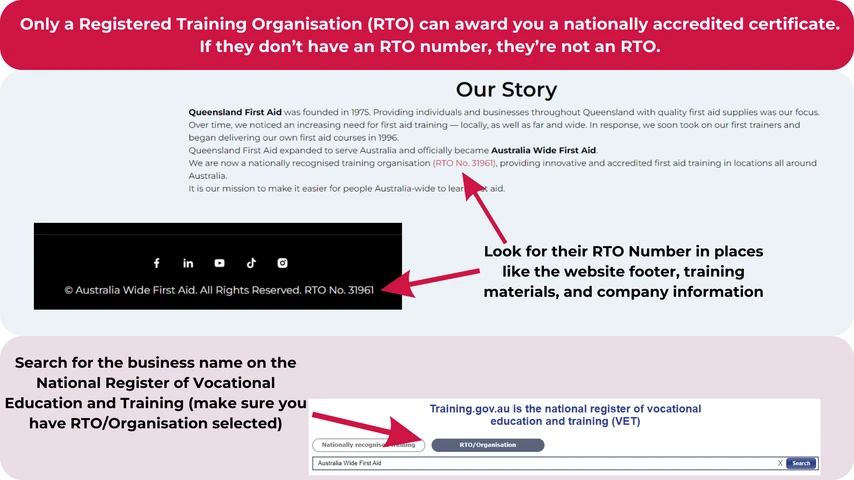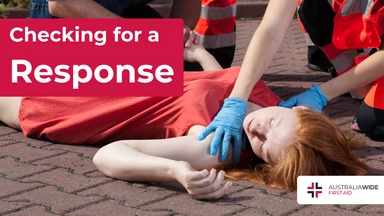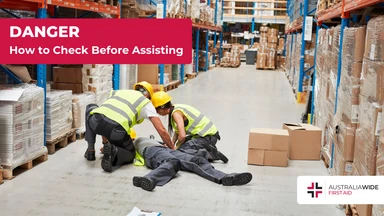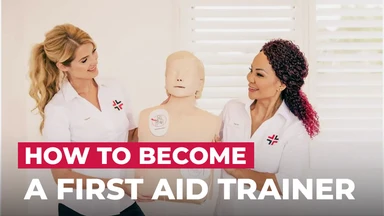How to Choose a First Aid Training Company


With a seemingly endless supply of offerings for CPR and First Aid training, it can be difficult to determine the best option for you.
A quick online search will offer you a multitude of options. Some of these options may be in-person only, or online only. Some may be from individuals with a YouTube channel, others, like us, are fully accredited training organisations.
So how can you tell if a provider is legitimate?
The first question to ask yourself is what is the purpose of your training?
Are you wanting to complete CPR or First Aid training for your own personal interest? As a requirement for your job?
The answer to those questions determines the route you should take. Either way, the skills and knowledge you will obtain are quite literally life-saving.
If you require a CPR or First Aid certificate for your work, then it needs to be accredited and recognised, provided by a registered training provider.
If you are seeking to upskill in these areas but do not need an official certificate, you could investigate other options. Just be aware that unless your training is recognised by the appropriate authorities, you may not be receiving the most up to date knowledge and skills.
You can get a ‘certificate’ for near about anything online, including first aid or CPR training. If you want your certificate to be registered and recognised, you need to complete your training through an registered training organisation (RTO).
RTOs are exactly as the name implies – a registered training organisation. Registered Training Organisations have been verified by either the Australia Skills Quality Authority, the only regulatory body who can determine if an organisation is eligible to issue a nationally recognised training course, and therefore certificate
These regulatory bodies ensure that each RTO is able to provide quality education and training. There is a rigorous assessment process, and continual audits and checks throughout the time an RTO is operating. Registration is renewed regularly, and each renewal includes an assessment process.
Each RTO is assigned a unique identifying number once they have been approved. They are legally required to display it. You can often find them in the footer of their website, and on their training materials.
Only a Registered Training Organisation (RTO) can issue you with an accredited certificate, which is what many workplaces require.
Many industries and workplaces require their employees to be formally trained in CPR and/or first aid.
There are formal recommendations for how to respond to emergency situations that require medical attention in the time before professional medical help can be obtained. These recommendations are based on current medical and scientific knowledge and are constantly being updated as knowledge and techniques evolve.
Sure, you can go onto YouTube and watch lots of videos about how to respond to an emergency. These videos, however, may contain outdated information, or even dangerously incorrect information.
Formal training, following official guidelines, ensures that the knowledge you are receiving is up to date and best-practice. This allows you to be confident that your knowledge and skills are going to be helpful, instead of harmful. Successful completion of a recognised CPR or First Aid Course, including all of the required training and assessment, is the only way to get your certificate.
Some places offer online CPR courses or online First Aid courses. It is vital to note that these are not fully accredited courses, and you cannot obtain accreditation or a statement of attainment by doing them.
Training in CPR and providing first aid must follow the guidelines determined by the Australian Resuscitation Council (ARC) and other national clinical bodies The full outlines of each course can be found on the Training website:
To obtain a certificate in these courses, the student must demonstrate certain knowledge and skills through formal assessments. Some of these skills must be observed in-person, others can be assessed through an exam or quiz.
One example of a skill that needs to be assess in person is the chest compressions necessary for CPR. These are demonstrated in a simulated environment (which can include virtually), with the aid of manikins.
You cannot demonstrate chest compression on a manikin in an online-only course, unless that course includes a portion of video-call with a trainer.
Likewise, you cannot practice using an automated external defibrillator (AED) through a simulation on your computer or laptop.
If a provider if offering an online-only option for first aid training, no doubt it will contain extremely valuable information, but it will not grant you certification.
If you don’t need certification, you should still ensure that the people behind the online course are an RTO. That way you can be assured that the information you are receiving is correct.
Your CPR certificate needs to be renewed every 12 months, and your First Aid certificate every 3 years.

There are a few simple steps you can take to ensure that you are receiving training from a reputable source.

March 18, 2025
Checking for a response is critical before proceeding with any first aid assistance. Knowing if a casualty is conscious or not allows you to use the appropriate techniques. Using gentle but firm responsiveness techniques, such as the COWS method, mean you can check for a response while remaining respectful to the casualty.

February 25, 2025
When coming across someone who appears unconscious, injured, or in need of medical help, it’s instinctive to rush to their aid. Ensuring the scene is safe before assisting the person is not only a fundamental principle of first aid but also critical to preventing further harm.

March 8, 2024
Becoming a first aid trainer in Australia is a rewarding and impactful career choice that allows individuals to make a significant contribution to the community by imparting life-saving skills.